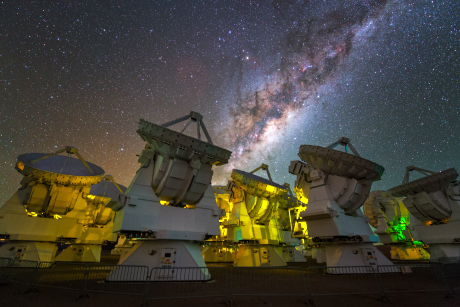Astronomers discovered complex carbon compounds for the first time at the sites of star formation.
Hunting at a distance of 27 thousand light years brought astronomers prey in the form of the sudden discovery of a carbon-based molecule — such a branching structure — in a giant gas cloud in interstellar space. As if finding a molecular needle in a haystack of cosmic hay, astronomers spotted radio waves emitted by isopropyl cyanide. This discovery means that complex molecules necessary for the origin of life may have interstellar origin.

With the help of the Atakam large millimeter / submillimeter grid known as the ALMA Observatory (a group of radio telescopes funded in part throughNational Science Foundation), scientists studied the gas field of formation of a new star Sagittarius B2.
Astronomers from Cornell, the Max Planck Institute for Radio Astronomy, and the University of Cologne (Germany) described their discovery in the Science magazine on September 26.
')
Organic molecules usually found in the areas of star formation consist of a single “string” of carbon atoms linked into a single chain. But the carbon structure of isopropyl cyanide branches, which makes its discovery the first discovery of such molecules in outer space, says Rob Garrod, senior researcher at the Center for Radiophysics and Space Research, Cornell University.
This discovery expands ideas about the complexity of molecules that can arise in interstellar space and are able, after all, to find their way onto the surface of the planets, says Garrod. The branching structure of isopropyl cyanide is a common property of molecules necessary for the origin of life, such as amino acids, which, in turn, are the building blocks for proteins. This news adds arguments in favor of the idea that biologically important molecules like amino acids, which are usually found in meteorites, arise at the very beginning of the process of the nucleation of stars - even earlier than planets like Earth.
Garod, along with lead author Arnaud Belloche and Karl Menten from the Max Planck Institute for Radio Astronomy, and Holger Muller from the University of Cologne, studied the chemical composition of Strelets B2, located near the center of the Milky Way galaxy and rich in organic molecules. .
ALMA allowed scientists to carry out a full spectral analysis in search of traces of new molecules with sensitivity and resolution 10 times higher compared with previous studies.
The ALMA Observatory is designed to study the origin of space objects using 66 sensitive radio antennas located in a high-altitude area with the dry air of the Atacama desert in northern Chile. These radio telescopes together form a giant "eye", peering into space.
“Understanding how organic material arises in the early stages of star formation is critically important in order to form a complete picture of the gradual transformation of simple molecules into potentially bearing the birth of a compound,” says Bellos.
About 50 unique traits inherent in isopropyl cyanide (and 120 to ordinary n-propyl cyanide, a straight carbon chain sibling) were found in ALMA in the Sagittarius B2 region. These two molecules - isopropyl cyanide and n-propyl cyanide - are also the largest molecules ever found in any of the areas of star formation.
[ suggest andorro news ]

With the help of the Atakam large millimeter / submillimeter grid known as the ALMA Observatory (a group of radio telescopes funded in part through
Astronomers from Cornell, the Max Planck Institute for Radio Astronomy, and the University of Cologne (Germany) described their discovery in the Science magazine on September 26.
')
Organic molecules usually found in the areas of star formation consist of a single “string” of carbon atoms linked into a single chain. But the carbon structure of isopropyl cyanide branches, which makes its discovery the first discovery of such molecules in outer space, says Rob Garrod, senior researcher at the Center for Radiophysics and Space Research, Cornell University.
This discovery expands ideas about the complexity of molecules that can arise in interstellar space and are able, after all, to find their way onto the surface of the planets, says Garrod. The branching structure of isopropyl cyanide is a common property of molecules necessary for the origin of life, such as amino acids, which, in turn, are the building blocks for proteins. This news adds arguments in favor of the idea that biologically important molecules like amino acids, which are usually found in meteorites, arise at the very beginning of the process of the nucleation of stars - even earlier than planets like Earth.
Garod, along with lead author Arnaud Belloche and Karl Menten from the Max Planck Institute for Radio Astronomy, and Holger Muller from the University of Cologne, studied the chemical composition of Strelets B2, located near the center of the Milky Way galaxy and rich in organic molecules. .
ALMA allowed scientists to carry out a full spectral analysis in search of traces of new molecules with sensitivity and resolution 10 times higher compared with previous studies.
The ALMA Observatory is designed to study the origin of space objects using 66 sensitive radio antennas located in a high-altitude area with the dry air of the Atacama desert in northern Chile. These radio telescopes together form a giant "eye", peering into space.
“Understanding how organic material arises in the early stages of star formation is critically important in order to form a complete picture of the gradual transformation of simple molecules into potentially bearing the birth of a compound,” says Bellos.
About 50 unique traits inherent in isopropyl cyanide (and 120 to ordinary n-propyl cyanide, a straight carbon chain sibling) were found in ALMA in the Sagittarius B2 region. These two molecules - isopropyl cyanide and n-propyl cyanide - are also the largest molecules ever found in any of the areas of star formation.
[ suggest andorro news ]
Source: https://habr.com/ru/post/238357/
All Articles